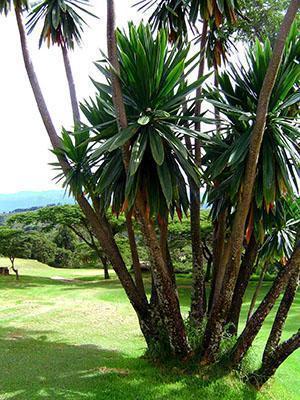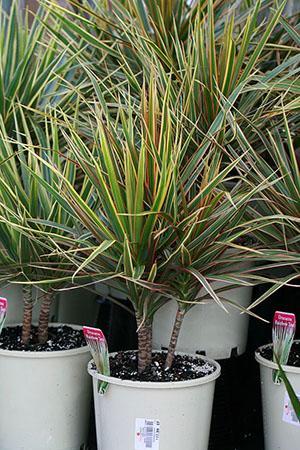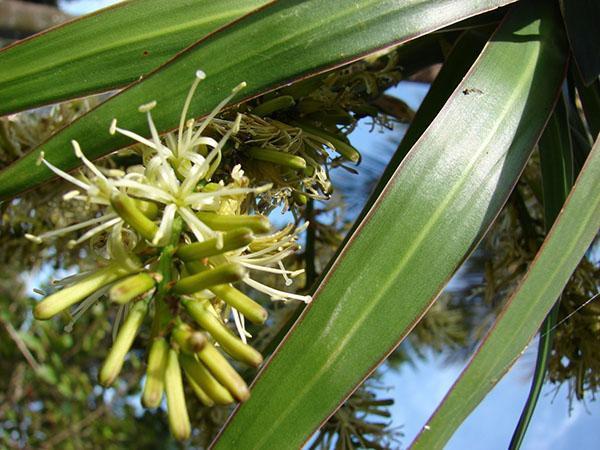Three popular types of dracaena in the photo with a description
 Dracaena are plants in dry, warm regions of South and Central America, Asia and Africa. In culture, you can most often see three types of dracaena, photos and descriptions of which are of particular interest to flower growers.
Dracaena are plants in dry, warm regions of South and Central America, Asia and Africa. In culture, you can most often see three types of dracaena, photos and descriptions of which are of particular interest to flower growers.
In nature, plants belonging to the Asparagus family are large, multi-meter trees with lignified trunks and leathery foliage of various sizes and colors. At home, dracaena is much smaller, but completely retain their specific features and characteristics.
Dracaena bordered (Dracaena reflexa var.angustifolia)

The appearance of the plant is very remarkable. When grown in a pot, dracaena forms a slender tree with a bare, gradually lengthening trunk. The tops of the shoots, which for a long time remain without lateral processes, are decorated with tough, pointed narrow foliage. Plants are much more powerful in nature. These are real trees, but they have the same linear leaves that sit tightly on the trunk, and their unpretentious disposition remains unchanged. By its name, a kind of dracaena, in the photo, owes a contrasting border, which is present on almost all litter of this plant.
 At home, far from the middle zone of Madagascar, dracaena actively blooms and forms fruits, but this occurs only in adult perennial specimens. At home, there is no need to wait for the formation of racemose inflorescences. It is all the more difficult to get ripe seeds, therefore dracaena, bordered vegetatively, multiplies.
At home, far from the middle zone of Madagascar, dracaena actively blooms and forms fruits, but this occurs only in adult perennial specimens. At home, there is no need to wait for the formation of racemose inflorescences. It is all the more difficult to get ripe seeds, therefore dracaena, bordered vegetatively, multiplies.
 The leaves are the pride of the popular dracaena species, and the photo and the name eloquently confirm this. The length of individual leaf plates reaches 70 centimeters. And their jagged edges are highlighted in contrast with pink or purple stripes of different widths. It is foliage that is the subject of interest of breeders who offer flower growers new spectacular varieties of dracaena bordered.
The leaves are the pride of the popular dracaena species, and the photo and the name eloquently confirm this. The length of individual leaf plates reaches 70 centimeters. And their jagged edges are highlighted in contrast with pink or purple stripes of different widths. It is foliage that is the subject of interest of breeders who offer flower growers new spectacular varieties of dracaena bordered.
 On the crown of the dracaena bordered by Colorama, several shades of green, pink and white are combined at once. The color of the foliage changes depending on the growing conditions and lighting.
On the crown of the dracaena bordered by Colorama, several shades of green, pink and white are combined at once. The color of the foliage changes depending on the growing conditions and lighting.
 Variety Bicolor is a light-colored foliage with white and green predominant colors, and a pink border around the edge is almost invisible.
Variety Bicolor is a light-colored foliage with white and green predominant colors, and a pink border around the edge is almost invisible.
The leaves of Tricolor plants are more red, and in addition to white, there is also a golden hue.
There are varieties in which the green color is practically not found, and the plant looks completely pink.
Dracaena deremskaya (Dracaena deremensis)
One of the three popular types of dracaena, photos and descriptions of which are discussed in the article, is dracaena deremskaya. Even at home, this culture is tall. Dracaena grown in a limited volume of a pot can reach a height of three meters. In nature, there are specimens that are many times higher and larger.
 Unlike the previous view dracaena on the photo deremskaya is densely decorated with foliage, and the leaves are located not only at the top, but also along a powerful upright trunk.Leaf plates up to half a meter long are often variegated. Green is combined with different shades of silver, white and yellow. The shape of the leaves is linearly widened, the surface is smooth, leathery to the touch.
Unlike the previous view dracaena on the photo deremskaya is densely decorated with foliage, and the leaves are located not only at the top, but also along a powerful upright trunk.Leaf plates up to half a meter long are often variegated. Green is combined with different shades of silver, white and yellow. The shape of the leaves is linearly widened, the surface is smooth, leathery to the touch.
At home, in the tropical regions of the African continent, plants bloom, but it is almost impossible to achieve the appearance of buds in the room. The resulting fruits are rounded orange juicy berries that hide dracaena seeds.
 Among cultivated varieties, Warneckii is in the lead in popularity. Such a deremskaya dracaena, the photo of which is presented in the article, will not go unnoticed thanks to the beautifully shaped leaves decorated with grayish and green stripes. No less decorative is the Lemon Lime variety, on the foliage of which there are dark and light green tones, separated by a narrow white edging.
Among cultivated varieties, Warneckii is in the lead in popularity. Such a deremskaya dracaena, the photo of which is presented in the article, will not go unnoticed thanks to the beautifully shaped leaves decorated with grayish and green stripes. No less decorative is the Lemon Lime variety, on the foliage of which there are dark and light green tones, separated by a narrow white edging.
 White Stripe amazes with an abundance of white color, White Jewel - with a bright light stripe along the edge of a dense green leaf plate.
White Stripe amazes with an abundance of white color, White Jewel - with a bright light stripe along the edge of a dense green leaf plate.
 Miniature varieties of large crops are always popular with lovers of indoor plants. Dracaena deremskaya, in the photo, is no exception. Janet Craig Compacta with completely green elastic leaves on a straight stem is a beautiful and very picky green pet for any apartment.
Miniature varieties of large crops are always popular with lovers of indoor plants. Dracaena deremskaya, in the photo, is no exception. Janet Craig Compacta with completely green elastic leaves on a straight stem is a beautiful and very picky green pet for any apartment.
Dracaena fragrant (Dracaena fragrans)
 Fragrant dracaena or fragrant got its name due to the pleasant smell emitted by the inflorescences that open on adult specimens. A flower stalk, almost a meter long, emerges from the center of the rosette, and then fluffy flowers resembling small pompons are revealed on it.
Fragrant dracaena or fragrant got its name due to the pleasant smell emitted by the inflorescences that open on adult specimens. A flower stalk, almost a meter long, emerges from the center of the rosette, and then fluffy flowers resembling small pompons are revealed on it.
You can see a spectacular sight in botanical gardens or in the homeland of culture, in the tropics in western Africa. At home, like other types of dracaena, the fragrant variety does not bloom.
 Wild specimens are large woody plants, and indoor varieties can be quite tall and dwarf. The common thing in this type of dracaena, as in the photo, is one thing - it is dense, juicy leaves that sit firmly on the trunk and are often beautifully curved. The length of the platinum sheet is up to 60 cm, the width is about 10 cm.
Wild specimens are large woody plants, and indoor varieties can be quite tall and dwarf. The common thing in this type of dracaena, as in the photo, is one thing - it is dense, juicy leaves that sit firmly on the trunk and are often beautifully curved. The length of the platinum sheet is up to 60 cm, the width is about 10 cm.
The foliage that falls over time opens a powerful trunk without side branches and shoots.
There are several varieties of this type of dracaena, photos of which are presented below. Plants differ in leaf color and size, but all cultivated varieties of dracaena are equally unpretentious and grow well in a room.
 The extremely popular Massangeana plant can be attributed to the tall dracaena. In the house, such a green pet grows up to one and a half meters in height and pleases the owners with bright yellow-green foliage.
The extremely popular Massangeana plant can be attributed to the tall dracaena. In the house, such a green pet grows up to one and a half meters in height and pleases the owners with bright yellow-green foliage.
 The Lindenii variety is equally interesting and attractive. Its foliage is distinguished by a green center and a wide creamy yellow stripe around the edges. But Surprise can be considered the most catchy and unusual. It is a dwarf plant with a height of only 20–40 cm with a crown that combines two shades of green and a pure white shade.
The Lindenii variety is equally interesting and attractive. Its foliage is distinguished by a green center and a wide creamy yellow stripe around the edges. But Surprise can be considered the most catchy and unusual. It is a dwarf plant with a height of only 20–40 cm with a crown that combines two shades of green and a pure white shade.
Dracaena fragrant always enjoys increased interest of flower growers, since bright plants perfectly coexist with other decorative cultures and easily adapt to the conditions of city apartments and offices.
What is this flower? And how to care for him? thank
Photograph the flower from different angles to show the growth.
Hello, please tell me what is the problem with the flower, how to fix it? Can you trim? Thank!!
Yes, the stain is not very good. Definitely not from the sun. I would check the root system of the bush, perhaps the problems are coming from there. It is better to replace the soil, you can treat it with a fungicide after transplanting. As for cropping - you can, of course, cut, but what will it change? The leaf will not grow back. But if you completely remove it, you can prevent the spread of the disease throughout the plant.
Olga, thank you very much for your comment! I bought a flower in the fall, planted it in fresh soil. For two months he has been standing on a glassed-in balcony. And in sunny weather and at night did not clean. Everything was good and here on you! Now I put it on the windowsill. And already on two sheets appeared. Change the soil, can you process the root with potassium permanganate?
Better with a fungicide.